Getting wheels
A rented Honda Dream manual 100cc step-through should set you back somewhere between 50,000 and 80,000 rupiah per day, depending on the quality of the bike, for two weeks. Out the front of your hotel in Kuta rentals may be a little higher, as it will be if you’re renting for a shorter time. Check the bike thoroughly. Make sure there is sufficient tread on the tires, that both the front and back brakes work well, and most importantly that the horn works and is LOUD. The bike should have a yellow registration form (laminated) that will be stored under the seat — don’t lose this! Your bike should come with a helmet. Wear it.

Check the bike carefully – no monkey business!
Not getting booked
You’ve already read our piece on how to avoid motorcycle fines in Bali, right? In theory you must have either an international license for riding or an Indonesian motorcycle license. Both are relatively easy to get if you have a motorbike license in your home country. You’re unlicensed? What are you doing? Consider rustling up two or three more live bods and hiring a small car — they’re cheap.
Not listening to us (or your Mum)? If you’re unlicensed and are pulled over, you may be asked to pay a fine/bribe on the spot — 50,000-100,000 rupiah is about right, though we’ve heard stories of people paying far more. Always be polite and expedite the situation as quickly as possible. They’ll also fine you if you’re spotted riding without a helmet. Unfortunately, they don’t seem to fine people for driving without shirts.
Bear in mind that if you have a motorbike (or car) accident in Indonesia and are unlicensed, as would be the case in your home country, your insurer may not be all that much help.

Sometimes it is easy to know where you are going
Get a map
Assuming you’re not planning on taking the main roads the whole way, to save yourself driving forever in circles or pulling over every 10 minutes to holler, “Candi Dasa di mana?” at some startled farmer, you need a good map. The best street map, by far, is the Periplus Bali Street Atlas. The 160-odd page atlas is available at most good bookstores in Bali and retails at around 200,000 rupiah. If you have some kind of a smartphone, Google or Apple Maps are excellent additions to a real map, not only because they’re remarkably detailed, but also, far more usefully, they will show you where on the map you are. Both STILL mark roads that don’t exist or are really just for goats, but in most cases they’re okay.

If only all signposting was this good
Not all animals are equal
Driving pecking order in Bali (and Indonesia for that matter) works on size taking right of way. Truck beats bus beats flatbed beats car beats motorbike beats bicycle beats pedestrian. This means you’ll see drivers doing extremely idiotic things on the road. Sometimes what you see and will be required to deal with will fly in the face of what you may have been taught in your home country, but the golden rule is to drive slowly, always yield, and, most importantly, be especially aware of motorcycles as they will be driving on the assumption that you know where they are. Don’t try to retain your lane just because it is your lane — it’s not — you’re just borrowing it from someone bigger than you.

Just about the only type of vehicle you probably won’t encounter
OK, enough of the small print, lets get started!
Sanur to Candi Dasa
We’re starting our trip around Bali from Sanur and aiming for Candi Dasa, a somewhat ageing resort town to the northeast of Sanur. It’s an easy 90-minute drive if you take the direct route, but we’re not going to do that.

Bridge crossing near Sukawati, Bali
The most direct route is along the coastal Prof Dr Ida Bagus Mantra Bypass (we just call it the “Kusamba Road”) — but it’s a big, heavily trafficked road with lots of trucks and dust — and you didn’t come to Bali for that did you?!
Instead, take an alternative inland route via Sukawati, Gianyar and Klungkung to Padang Bai and Candi Dasa. Take the Kusamba Road as far as Ketewel, then take a left up to Sukawati, then dog leg your way left and right up through this rice-growing region till you hit the south side of Gianyar.
There are no signposts at all along this route so have a map and be prepared to get lost. Roughly speaking the route takes you through the villages of Giwang, Sukawati, Saba, Belege and Bona to Gianyar. The scenery is pretty and best of all there is no traffic at all.
Eventually, you’ll reach the south side of Gianyar. From here, unless you’ve got the time (and navigational skills) to go well out of your way to the north, it is a better idea to stick on the main road through to Klungkung — the traffic will have dropped off anyway. On the east side of Klungkung you’ll pass an impressive weir, climb out of town and then it is a straightforward run down to Kusamba and, after that, our first rest stop.

A seafood lunch at Padang Bai
The black-sand beach at Goa Lawah is dotted with beachside warungs where you can pick up a bakso and a cold drink for a reasonable price. Once you’re fed and watered, pop over and hire a sarong for a visit to Goa Lawah, one of Bali’s cardinal temples. Allow an hour for lunch and a visit to the temple.
From here it’s about 30 minutes to the turn-off to the port town of Padang Bai and another 30 minutes to Candi Dasa. Padang Bai is well regarded for Blue Lagoon — an excellent snorkelling spot — and the town also has some quite good seafood restaurants. Being a port town (this is the main departure point to Lombok) there are plenty of places to stay in Padang Bai, from cheapie flophouses to quite luxurious digs, but overall we’d say this isn’t our favourite spot in Bali.

White Sand Beach near Candi Dasa, Bali
So after lunch head back to the main road and it is another 30 minutes to Candi Dasa town. Candi Dasa is worth at a minimum an overnight stay, but you could easily justify a three-night stop here, with one day spent snorkelling around the islands followed by an afternoon jaunt to the Bali Aga village of Tenganan, one day at White Sand Beach (Pantai Putih) and one day visiting Tirta Gangga.

Just another Candi Dasa sunset
Candi Dasa to Amed
For those doing a quick loop of Bali, from Candi Dasa the next logical stop is Amed, a beachside series of bays about an hour and a half north. Amed is known for its black-sand beaches, off-the-beach snorkelling and volcano vistas — it forms one of those all-round pleasurable-place-to-hang-around-for-a few-days destinations. We like it a lot.

Taking the back road out of Candi Dasa
As with the first leg of the trip, there are a couple of routes you can take to get you to Amed. The more direct route takes you more or less due north via Amlapura and Tirta Gangga with a hard right at the end, while the scenic route takes you via the coast road, snaking by Ujung Water Palace and the easternmost point of Bali. You know which way we’re going to send you, right?
About 10 minutes out of Candi Dasa, the road winds and turns back on itself until you reach a layover for a shrine and a viewpoint reached by a 45-minute hike. The views are spectacular, but when we found what looked to be an especially scenic vantage point to the north, we also found a six-foot stark naked Westerner standing there. He was friendly enough, giving us a polite wave, but we decided to keep the camera in our pocket. Otherwise, there are also a lot of monkeys.

Viewpoint: before tall nude guy
Back on the road, continue by the turn-off to Jasri beach. Once a good surfing spot, sadly the beach started to get sucked away and a retaining wall was built that forever changed the waves. If you feel like staying, the charming and very secluded (and near impossible to find!) Turtle Bay Hideaway is fab.

Dawn at Jasi Beach, a world away from delayed flights and Kuta madness
Pressing onwards, pass the right turn-off for Jasri Beach, take a hard left and then take any of the next few lanes to the right and dogleg your way through to the main-ish road and follow it through to Ujung Water Palace. Allow at least an hour to wander the grounds.

Ujung Water Palace, near Jasri Beach, Bali
From here on you’ll be sticking to the mostly unsignposted coast road. The only town of any real size you’ll pass through before Amed is Seraya (where you take a right at the top of the hill — don’t go straight ahead!). The road is narrow and very winding, but particularly scenic and there is close to zero traffic. A cluster of places to stay are on offer near Seraya (including well-regarded Seraya Shores) but after that there is close to nothing until the easternmost bays at Amed.

Songan Beach, Karangasam, Bali
Eventually you’ll reach a small bridge with a signposted hard-right to Pantai Songan — Songan beach is a glorious little black-sand beach reached by a steep stone staircase and forms a top spot to take a refreshing swim. With the deep blue of the ocean, jet-black sand and white fishing boats, this is an especially photogenic spot.

Banyuning Beach, Amed
From Songan onwards, just keep on going. Eventually you’ll see a signpost for Golden Rock Retreat, a detox health resort marking the southernmost end of Banyuning village. From here the coast stretches for 10 kilometres or so with a half-dozen beaches and villages till you reach Amed village proper. Each beach has its own pros and cons, activities and Amed has a range of hotels and guesthouses.
Amed to Lovina
Compared to the winding coastal route from Candi Dasa to Amed, the road onwards to Lovina is a breeze. It’s a long drive, but plain sailing with barely a hill along the way. Immediately upon leaving the coastal strip of Amed you veer inland through Culik, then slowly start to work your way west along Bali’s northern coastline to the diving centre of Tulamben.

Between Amed and Lovina there is a big hill
In 1942, the USAT Liberty was en route from Australia to the Philippines when it was torpedoed by a Japanese sub in the Lombok Strait. The Liberty wasn’t sunk however and limped westward trying to make it to the port at Singaraja. It ended up being beached at Tulamben where it lay for the next 21 years, till lava from Agung’s eruption in 1963 pushed the vessel off the beach and back into the ocean — creating one of Bali’s more popular diving destinations. If you’re diving, there are a bunch of affordable hotels in Tulamben to choose from.

Les Waterfall is a minor diversion not too far from Tulamben
Otherwise, pushing on, before you know it you’ll be rolling into Bali’s northern capital, Singaraja. Keep your nerve and follow the traffic and before you know it you’ll be thrust out the other side of town from where it is just another 10 minutes to the sleepy black sands of Lovina.

Time out during cremation ceremony in Singaraja
Like the area referred to as Amed, Lovina is actually a string of villages starting with Anturan then followed by Banyualit, Kalibukbuk and Kaliasem. Kalibukbuk is the centre of the “scene” with plenty of places to stay, eat and relax. Lovina is best known for its dolphins and you’ll be near continually harangued to do a boat trip of one kind or another — that the dolphins keep coming back really left us wondering if they really are as smart as people say.

Early morning beachside at Kaliasem, Lovina
Lovina to Pemuteran
From Lovina it’s an easy ride along the northwest coast of Bali to reach the diving and snorkelling beachside hideaway of Pemuteran. The road skirts the coastline for much of the way and aside from the rising hills to the south it’s really a bit of an uneventful ride, with junction town Seririt being the only settlement of any size that you’ll pass through.

Bye Bye Lovina
If you are wanting to break up the trip, your first stop should be at the Banjar Hot Springs, some 11 kilometres to the west of Lovina: lookout for a sign reading “Air Panas Banjar”. From the turnoff it is another five kilometres to the springs themselves.

Wash off the grime at the Banjar hot springs
Another stop, we’d say a close to essential stop, is Kali Manik. Kali Manik is an eco-beach getaway that delivers fantabulous food in a lovely setting. Do check it out, and allow a few hours as the food takes a while. Have the time and money? Stay overnight.
Pemuteran is known for four things. It’s famous for a trio of temples, a reef regeneration project and for being a jumping off point to both stunning Menjangan Island and also West Bali National Park. Much of the beach is lined with mid-range and up resorts. Those on a budget will be off the beach, but don’t fret as some good budget digs do lie on the off-beach side of the road.

Travelling with young kids means you always get to see sunrise. This one in Pemuteran.
Once you’re done with Pemuteran itself, take a trip to the pier for Menjangan Island, from where you can arrange a boat transfer across to the island for a spot of snorkelling (or diving). When the visibility is clear and when there isn’t a ton of plastic on the surface (a common problem), the reef and fish here are world class and certainly the best we’ve seen anywhere in Bali.

Even the boat landings in West Bali are scenic!
The boat trip doesn’t come all that cheap, and comes with a mandatory guide (who will snorkel with you) so try to rustle up a group in Pemuteran, else hang out at the pier and try to wangle your way onto someone else’s boat. Allow a full day to get the most out of a trip.

No photoshop required. The water really is that blue.
The second trip out from Pemuteran is trekking into West Bali National Park. A trek here will take you through the forest to hang out with the local macaque monkey population and, if you’re lucky, other animals. The forest is hot and humid and at times physically demanding, so take plenty of water.

Stormy skies on the Menjangan run
Pemuteran to Medewi
Leaving Pemuteran heading west, you’ll reach a junction with a spur that runs off to the ferry at Gilimanuk. From here it is a long and at times hair-raising drive to Medewi via the larger town of Negara.
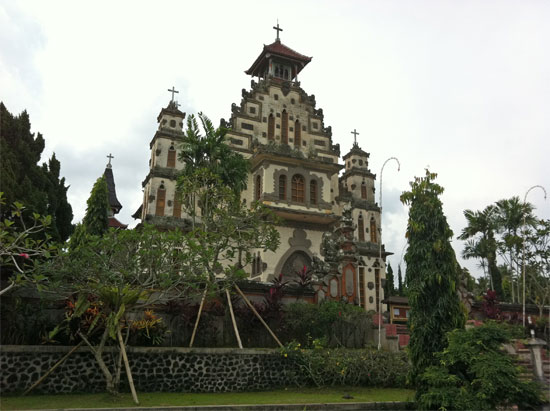
Not what you expect to see in rural Bali.
One way to take a breather is to take a sidetrip to the twin Christian towns of Blimbingsari and Palasari, which lie inland. Both were established to make a home for Catholics (Blimbingsari) and Protestants (Palasari) who were exiled from south Bali in the 1930s. Note that as usual in Bali the signposting isn’t very good, but they’re roughly 30 kilometres shy of Negara.

Just another slice of rural scenery.
Onwards from Negara the road veers back towards the coast, eventually rounding a bend and depositing you at Medewi. Medewi is primarily a surfing area and we are very fond of it; we’ve written already both about the beach and a very special homestay. Even if you have no interest in surfing, we highly recommend a stop.
Medewi to Munduk
From Medewi you have two options: continue east along the coast to Balian and beyond or veer inland. We’re going to opt for the latter and take a left turn at the main junction over the river heading west and take the road to Pupuan.
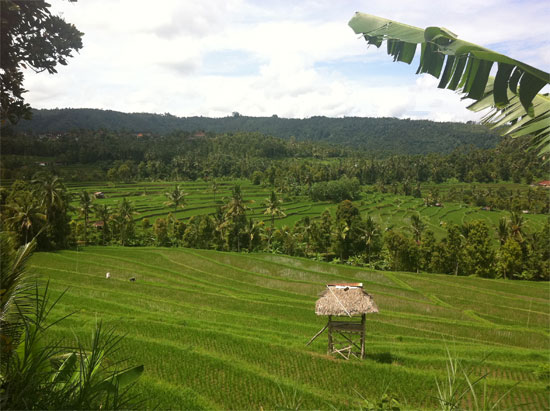
On the way to Munduk.
It’s an all-weather road, narrow in places, but fine by either motorbike or car and it quickly scales up the slopes that overlook Medewi and the rest of this coastal stretch of Bali. The views back over the beaches are stunning, so take your time and stop for pics when you can.
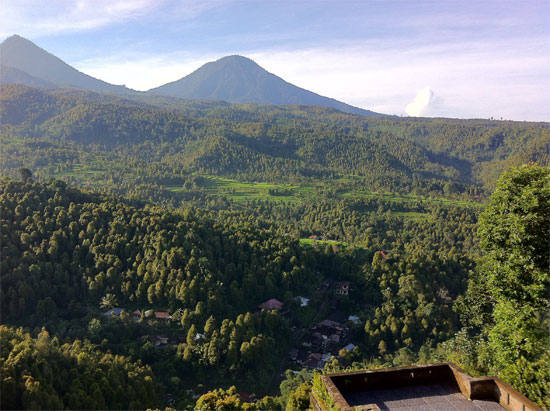
Just another day in Munduk.
Eventually you’ll hit the turn-off (there are two, either works) to the right to Munduk which sits atop a ridge snaking up the volcano’s slope. On a clear day you can easily see the Bali Sea to the north and the densely forested slopes to the south. The town is small, but there are plenty of places to stay in Munduk and a smattering of eateries. Activities include trekking, visiting nearby waterfalls.
Munduk to Bedugul
Our first piece of advice, assuming the weather is clear, is to leave Munduk as early as possible to see dawn over Lakes Tamblingan and Buyan. While three lakes are clustered around the Bedugul caldera, these two offer the best views and in the early morning, weather providing, it is just stunning. Once you’re done taking in the view, continue west to where you double back and wind down the inner rim of the caldera to reach Bedugul proper.

Oh so pretty.
Along the way, you’ll drive through numerous signposts for organic farms, with strawberries especially popular. Much of the fresh produce you’ll buy elsewhere in Bali comes from around Bedugal. Sweet things aside, Bedugul is known for Pura Ulun Danu Beratan, located just off the shore of Lake Beratan at 1,200 metres above sea level. As with Tanah Lot on the south coast, this temple is a highlight on most “Bali in a day by bus” tours and it’s a serious tourist trap. While it is worth a quick stop, we’d be inclined to dedicate more time to the Bali Botanic Garden sitting just outside of town.
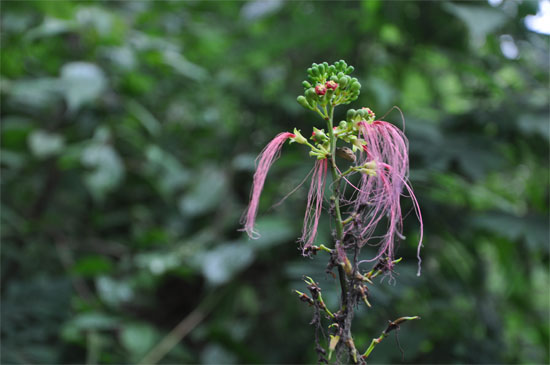
Pretty everywhere.
Bedugul to Canggu
From here it’s a straight run downhill to Bali’s southern beaches and, after all the beautiful scenery you’ll have seen by this stage, you’ll be shocked by the traffic and overdevelopment that blights this part of Bali. Coming from the north, the main beach areas are (broadly speaking) Canggu, Seminyak, Legian, Kuta and, after the airport, Jimbaran. Each area will appeal to a different type of traveller.
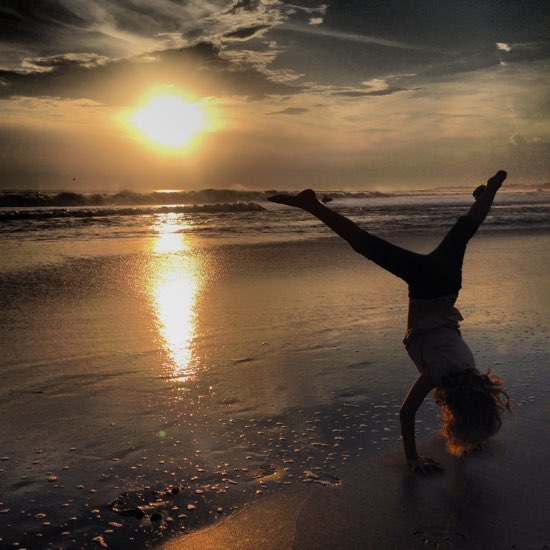
Batu Belig is great upside down too.
If you barrel straight down to the beach, our advice is really just to pick which beach you’re aiming for and get the drive over and done with. Those on tight budgets will be best served in Kuta, though affordable homestays and dorms can be found in the other areas. If you have more budget, the further north you stay the happier you’ll be. Clubbers and food fans will probably want to settle in Seminyak, which still boasts some of the beast eating and boozing in south Bali (with the traffic to match).
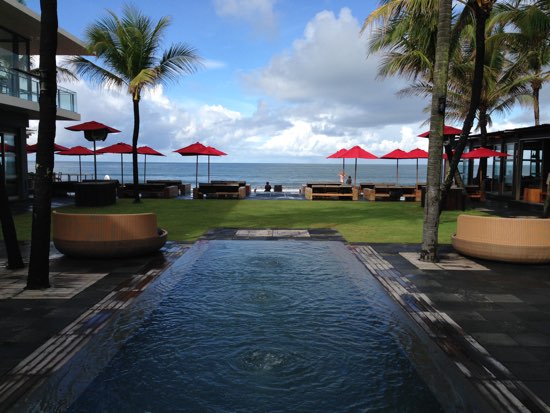
Ku De Ta: Don’t forget your big sunglasses.
Some people visiting Bali get no further than these beaches you’ve just arrived at, so if you want to indulge your inner beach bum, you’ll want to settle in here for a few days. Note that year round trash is a big problem on these beaches and in wet season it can be especially unsightly and dirty. Want some photos sunbaking beside washed up nappies? Seminyak in February should be just about right. Authorities are working to address it, but action is slow and haphazard sadly.
Beach to the Bukit
This is our final leg. Really! Once you’re done with the beaches, head further south — enjoy Bali at its traffic-rammed best and cruise on by the airport to start the climb onto the Bukit peninsula. This large block of limestone glued onto the southern end of Bali proper is famous for its beaches and clifftop accommodation.
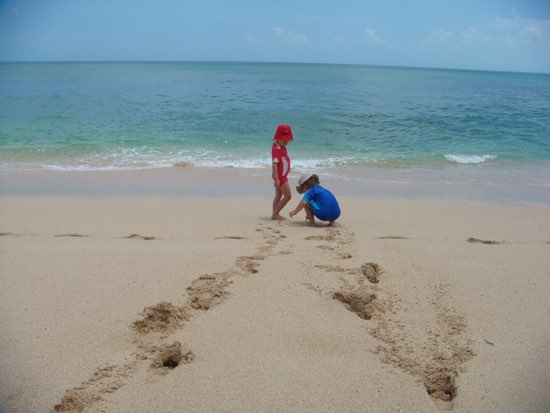
The surf is not always up at Balangan.
On the southeast coast of the Bukit lies Nusa Dua, a contrived luxury Disney-esque bubble home to a string of five-star lux resorts — we’re not fans and this area is totally skippable. But on the west coast lie a string of terrific beaches and we’d recommend choosing one to finish up your loop before driving back to Sanur. Which to try? We’ve a soft spot for Balangan, Bingan and Padang Padang (we boycott Dreamland).
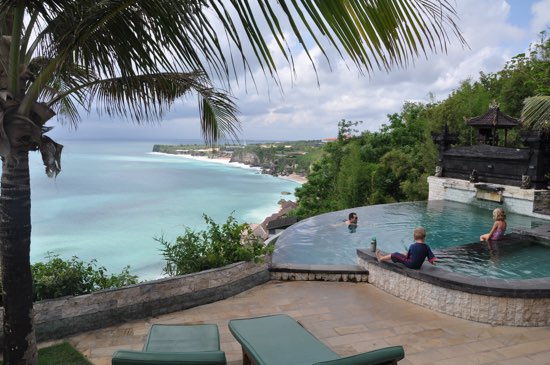
There are worse places to finish off a drive around Bali.
Whichever beach you settle on, make sure you fit in seeing a kecak dance at Uluwatu. Yes, it is a touristy affair, but the setting is spectacular and it’s a fabulous way to round out a trip to Bali before pushing on. You’re heading to Lombok next right?
Reviewed by
Stuart McDonald
Stuart McDonald co-founded Travelfish.org with Samantha Brown in 2004 and has been writing about travel in Southeast Asia since 1997. He has lived in Thailand, Cambodia and Indonesia, where he worked as an under-paid, under-skilled language teacher, an embassy staffer, a newspaper web-site developer, freelancing and various other stuff. He’s also the author of Couchfish, a Southeast Asia travel and sustainable tourism newsletter. In his spare time he’s doing his Masters in Responsible Tourism Management at Leeds Beckett University in the UK.
